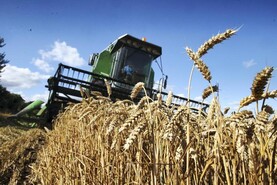Any visitor to the country this week that has yet to make it beyond the M50 would be forgiven for thinking that, based on national media reports and comments from some of our politicians, rural Ireland had been stripped bare by 'Big Ag' in the pursuit of industrial farming.
The image of US-style feedlots would certainly be front of mind rather than the patchwork quilt of family farms that actually exists.
The narrative is hugely demoralising for a farming community that comprises of over 100,000 farm families – farm families that ultimately work every day with a goal of ensuring that they improve their farms for the next generation, while producing safe, nutritious food.
In this environment, it is important that farmers do not lose sight of the fact that the vast majority of society appreciates the work they do.
Consumers – nationally and internationally – recognise the efforts of Irish farmers in ensuring that they have access to the highest quality, most nutritious and safest food in the world, produced to some of the most stringent welfare and environmental standards. It also happens to be one of the most carbon-efficient in the world.
Environmental footprint
To highlight this is not to distract from the important role that these farm families can and must play in reducing the environmental footprint of food production. In the context of tackling climate change, it is fair that agriculture is being challenged strongly to reduce emissions. But it is a challenge that farmers can and will rise to.
The KPMG economic impact assessment into emission reduction targets on agriculture identifies scope to reduce agricultural emissions by 13-18% while protecting farm incomes.
To maintain credibility, it is imperative that over the next decade all stakeholders work to ensure these technologies are available to farmers and rolled out across all farms.
But what would not be fair would be for Government to simply announce later today (Thursday) an emission reduction target for agriculture in the absence of a detailed policy and financial framework.
It is not acceptable for Government or those lecturing farmers on the need for change to dismiss the threat to farm incomes
Targets and sound bites don’t achieve results – a policy vision that engages and incentivises farmers does. Therefore, such a framework must detail the policy measures that will be implemented to deliver on whatever ambition the Government sets for the sector.
Alongside this, the financial instruments that will be deployed to drive the necessary behavioural change while also protecting farm incomes and rural communities must be detailed.

Minister for Agriculture Charlie McConalogue.
It is not acceptable for Government or those lecturing farmers on the need for radical change , including Minister for State Pippa Hackett in Portlaoise this week, to simply dismiss the threat to farm incomes on the basis that new alternative income streams will emerge in the future.
Forestry and the renewables have been suggested as examples of such alternatives yet we see a failure in policy forcing farmers out of forestry while excluding them from any meaningful participation within the renewable energy sector.
Others have suggested organics as the great white knight that will address the income challenge within the low-income beef and sheep sectors – but again such projections appear to be based more on hope rather than any detailed market or economic analysis.
Despite many promoting organics at farm level, Dutch research shows an unwillingness by consumers to pay what is necessary to make organic production viable for large volumes.
Other sources of income
In a recent interview with the Irish Farmers Journal, vice-president of the World Wildlife Fund Jason Clay made clear that, in future, producing food will not be the only income stream for farmers.
He pointed to the delivery of clean air, improved water quality, increased biodiversity and habitat renewal as new emerging revenue streams along with the opportunities of anaerobic digestion.
But to date, we have seen no attempt by Government to develop policy that properly rewards farmers for these indirect eco-system services.
Speaking at an Irish Farmers Journal briefing this week, chair of the Climate Change Advisory Council Marie Donnelly was very clear on the need to change policy if the current policy isn’t working.

Ultimately, whatever targets are set for agriculture today are only at the beginning of a journey. It is a journey where cuts to the national herd will continue to be put forward as the easy solution if we fail to fund research to identify and implement new mitigation technologies.
A much more intense focus on the development of new emission-reduction technologies is required while also advancing a scientifically robust model that allows farmers to verify the level of carbon sequestered on farms.
Key stakeholders within the industry, Teagasc and our universities must be ambitious, forward-thinking and prepared to learn from others if we are to move from talking about the potential of technologies to proving their impact at farm level.
In this regard we should look to Northern Ireland. The recent announcement of a new scheme to establish baseline carbon in soils across the north is to be commended. It should be mirrored across the whole island.
Establishing a baseline is the first step in farmers receiving proper acknowledgement for the carbon that they are sequestering on their farms.
We cannot be talking about carbon sequestration in five years’ time. We must be in a position to verifiably establish the levels sequestered while also presenting a technology road map that takes the sector beyond the capacity to reduce emissions by 18%.
Any visitor to the country this week that has yet to make it beyond the M50 would be forgiven for thinking that, based on national media reports and comments from some of our politicians, rural Ireland had been stripped bare by 'Big Ag' in the pursuit of industrial farming.
The image of US-style feedlots would certainly be front of mind rather than the patchwork quilt of family farms that actually exists.
The narrative is hugely demoralising for a farming community that comprises of over 100,000 farm families – farm families that ultimately work every day with a goal of ensuring that they improve their farms for the next generation, while producing safe, nutritious food.
In this environment, it is important that farmers do not lose sight of the fact that the vast majority of society appreciates the work they do.
Consumers – nationally and internationally – recognise the efforts of Irish farmers in ensuring that they have access to the highest quality, most nutritious and safest food in the world, produced to some of the most stringent welfare and environmental standards. It also happens to be one of the most carbon-efficient in the world.
Environmental footprint
To highlight this is not to distract from the important role that these farm families can and must play in reducing the environmental footprint of food production. In the context of tackling climate change, it is fair that agriculture is being challenged strongly to reduce emissions. But it is a challenge that farmers can and will rise to.
The KPMG economic impact assessment into emission reduction targets on agriculture identifies scope to reduce agricultural emissions by 13-18% while protecting farm incomes.
To maintain credibility, it is imperative that over the next decade all stakeholders work to ensure these technologies are available to farmers and rolled out across all farms.
But what would not be fair would be for Government to simply announce later today (Thursday) an emission reduction target for agriculture in the absence of a detailed policy and financial framework.
It is not acceptable for Government or those lecturing farmers on the need for change to dismiss the threat to farm incomes
Targets and sound bites don’t achieve results – a policy vision that engages and incentivises farmers does. Therefore, such a framework must detail the policy measures that will be implemented to deliver on whatever ambition the Government sets for the sector.
Alongside this, the financial instruments that will be deployed to drive the necessary behavioural change while also protecting farm incomes and rural communities must be detailed.

Minister for Agriculture Charlie McConalogue.
It is not acceptable for Government or those lecturing farmers on the need for radical change , including Minister for State Pippa Hackett in Portlaoise this week, to simply dismiss the threat to farm incomes on the basis that new alternative income streams will emerge in the future.
Forestry and the renewables have been suggested as examples of such alternatives yet we see a failure in policy forcing farmers out of forestry while excluding them from any meaningful participation within the renewable energy sector.
Others have suggested organics as the great white knight that will address the income challenge within the low-income beef and sheep sectors – but again such projections appear to be based more on hope rather than any detailed market or economic analysis.
Despite many promoting organics at farm level, Dutch research shows an unwillingness by consumers to pay what is necessary to make organic production viable for large volumes.
Other sources of income
In a recent interview with the Irish Farmers Journal, vice-president of the World Wildlife Fund Jason Clay made clear that, in future, producing food will not be the only income stream for farmers.
He pointed to the delivery of clean air, improved water quality, increased biodiversity and habitat renewal as new emerging revenue streams along with the opportunities of anaerobic digestion.
But to date, we have seen no attempt by Government to develop policy that properly rewards farmers for these indirect eco-system services.
Speaking at an Irish Farmers Journal briefing this week, chair of the Climate Change Advisory Council Marie Donnelly was very clear on the need to change policy if the current policy isn’t working.

Ultimately, whatever targets are set for agriculture today are only at the beginning of a journey. It is a journey where cuts to the national herd will continue to be put forward as the easy solution if we fail to fund research to identify and implement new mitigation technologies.
A much more intense focus on the development of new emission-reduction technologies is required while also advancing a scientifically robust model that allows farmers to verify the level of carbon sequestered on farms.
Key stakeholders within the industry, Teagasc and our universities must be ambitious, forward-thinking and prepared to learn from others if we are to move from talking about the potential of technologies to proving their impact at farm level.
In this regard we should look to Northern Ireland. The recent announcement of a new scheme to establish baseline carbon in soils across the north is to be commended. It should be mirrored across the whole island.
Establishing a baseline is the first step in farmers receiving proper acknowledgement for the carbon that they are sequestering on their farms.
We cannot be talking about carbon sequestration in five years’ time. We must be in a position to verifiably establish the levels sequestered while also presenting a technology road map that takes the sector beyond the capacity to reduce emissions by 18%.








 This is a subscriber-only article
This is a subscriber-only article










SHARING OPTIONS: